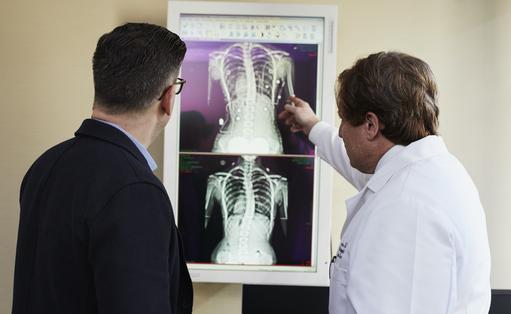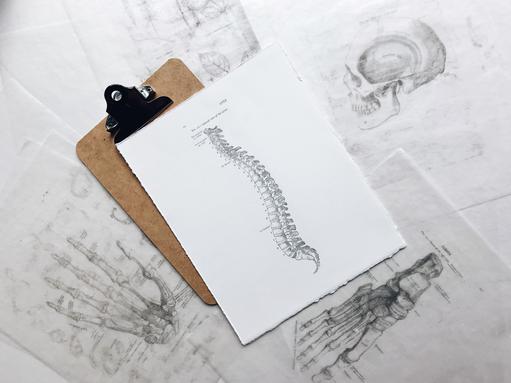|
Prelude to surgery
Despite the range of non-invasive therapies for LBP, the incidence of lumbar spinal fusion surgery for ordinary LBP increased significantly over the past 2 decades without definitive evidence of the efficacy of the procedure. Recent guidelines from UK and US regulatory bodies have instructed doctors to consider more conservative therapies for the management of back pain, and this has resulted in the reduction in the incidence of spinal fusion surgeries.
Notwithstanding, because there has been clear recognition of the paucity of evidence for reliable rates of improvement following fusion for back pain surgery, it does not necessarily follow that fusions should never be done and indeed there are many instances where fusions are strongly supported by evidence. The gold standard for diagnosing degenerative disc disease is MRI evidence, which has formed the principal basis for surgical decisions in older adults. However, studies suggest that although MRI evidence indicates that degenerative change in the lumbar spine is common among people over 60, the overwhelming majority do not have chronic LBP.
Increasing prevalence of spinal fusion surgery
Each year, NHS England undertakes some 10,000 spinal surgeries for LBP at a cost of some £200m, which is in addition to the large and growing number of patients receiving epidurals that cost the NHS about £9bn a year, and they too have low evidence as to their efficacy. In the US more than 300,000 back surgeries are performed each year. In 10 to 39% of these cases, pain may continue or even worsen after surgery; a condition known as ‘failed back surgery syndrome’. In the US, about 80,000 new cases of failed back surgery syndrome are accumulated each year. Pain after back surgery is difficult to treat, and many patients are obliged to live with pain for the rest of their lives, which causes significant disability.
Back pain and premature death
A study by researchers from the University of Sydney published in 2017 in the European Journal of Pain found that older people with persistent chronic back pain have a higher chance of dying prematurely. The study examined the prevalence of back pain in nearly 4,400 Danish twins over 70. They then compared their findings with the death registry and concluded that, "Older people reporting spinal pain have a 13% increased risk of mortality per year lived, but the connection is not causal." According to lead author Matthew Fernandez, “This is a significant finding as many people think that back pain is not life-threatening.” Previous research has suggested that chronic pain can wear down peoples’ immune systems and make them more vulnerable to disease.
Spinal fusion
While recognizing that a relatively small group of elite spine surgeons, mostly from premier medical institutions, regularly carry out essential complex surgeries required for dire and paralysis-threating conditions such as traumatic injuries, spinal tumors, and congenital spinal abnormalities, the majority of procedures undertaken by a significant number of spine surgeons have been elective fusion procedures for people diagnosed with pain, which is referred to as “axial”, “functional” and “ non-specific”. People most likely to benefit from spine surgery are the young, fit and healthy. This is according to a study undertaken by the American Spine Research Association. Notwithstanding, the study also suggests that the typical American candidate for spinal fusion surgery is an overweight, over 55 year old smoker on opioids.
Steady growth projected for the spinal fusion market
The spine surgery market is relatively mature and dominated by a few global corporations: Medtronic, DePuy, Stryker, and Zimmer-Biomet. According to a 2017 report from the consulting firm GlobalData the market for spinal fusion, which includes spinal plating systems, interbody devices, vertebral body replacement devices, and pedicle screw systems is set to rise from approximately US$7bn in 2016 to US$9bn by 2023, representing a compound annual growth rate of 3.4%. The increasing prevalence of age-related degenerative spinal disorders, and continued technological advances in spinal fusion surgeries, such as expandable interbody cages and navigation systems, and the increased adoption of minimally invasive techniques, have driven this relatively steady market growth.
Spinal fusion surgery
Lumbar spinal fusion surgery has been performed for decades. It is a technique, which unites - fuses - 1 or more vertebrae to eliminate the motion between them. The procedure involves placing a bone graft around the spine, which, over time, heals like a fracture and joins the vertebrae together. The surgery takes away some spinal flexibility, but since most spinal fusions involve only small segments of the spine the surgery does not limit motion significantly.
Lumbar spinal fusion
Fusion using bone taken from the patient - autograft - has a long history of use, results in predictable healing, and currently is the “gold standard” source of bone for a fusion. One alternative is an allograft, which is cadaver bone that is typically acquired through a bone bank. In addition, several artificial bone graft materials have been developed, and include: (i) demineralized bone matrices (DBMs), which are created by removing calcium from cadaver bone. Without the mineral the bone can be changed into putty or a gel-like consistency and used in combination with other grafts. Also it may contain proteins that help in bone healing; (ii) bone morphogenetic proteins (BMPs), which are powerful synthetic bone-forming proteins that promote fusion, and have FDA approval for certain spine procedures, and (iii) ceramics, which are synthetic calcium/phosphate materials similar in shape and consistency to the patient’s own bone.
Different approaches to fusion surgery
Spinal fusion surgery can be either minimally invasive (MIS) or open. The former is easily marketable to patients because smaller incisions are often perceived as superior to traditional open spine surgery. Notwithstanding, open fusion surgery may be performed using surgical techniques that are considered "minimally invasive", because they require relatively small surgical incisions, and do minimal muscle or other soft tissue damage. After the initial incision, the surgeon moves the muscles and structures to the side to see your spine. The joint or joints between the damaged or painful discs are then removed, and then screws, cages, rods, or pieces of bone grafts are used to connect the discs and keep them from moving. Generally, MIS decreases the muscle retraction and disruption necessary to perform the same operation, in comparison to the traditional open spinal fusion surgery, although this depends on the preferences of individual surgeons. The indications for MIS are identical to those for traditional large incision surgery. A smaller incision does not necessarily mean less risk involved in the surgery.
There are three main approaches to fusion surgery, (i) the anterior procedure, which approaches your spine from the front and requires an incision in the lower abdomen, (ii) a posterior approach is done from your back, and (iii) a lateral approach from your side.
Difficulty identifying source of back pain
A major obstacle to the successful treatment of spine pain by fusion is the difficulty in accurately identifying the source of a patient’s pain. The theory is that pain can originate from spinal motion, and fusing the vertebrae together to eliminate the motion will get rid of the pain. Current techniques to precisely identify which of the many structures in the spine could be the source of a patient’s back pain are not perfect. Because it can be challenging to locate the source of pain, treatment of back pain alone by spinal fusion is somewhat controversial. Fusion under these conditions is usually viewed as a last resort and should be considered only after other nonsurgical measures have failed.
Spinal fusion surgery is only appropriate for a very small group of back pain sufferers
Nick Thomas, also a consultant neurosurgeon at King’s College Hospital Trust, London and the London Neurosurgery Partnership suggests there are a scarcity of preoperative tests to indicate whether spinal lumbar fusion surgery is appropriate, and stresses that spinal fusion is appropriate only for a small group of patients who present with back pain.
“The overwhelming majority of patients who present with low back pain will be treated non operatively. In a few very select cases, spinal fusion may be appropriate. A challenge in managing low back pain is that there are precious few pre-operative investigations that give a clear indication of whether a spinal fusion may or may not work. Even with MRI evidence it can be very difficult to determine whether changes in a disc are the result of the normal process of degeneration or whether they reflect a problem that might be generating the back pain. If patients fail to respond to non-operative treatments they may well consider spinal fusion. A very small group of patients, who present with a small crack in one of the vertebrae bones - pars defect - or slippage of the vertebrae - spondylolisthesis - may favorably respond to spinal fusion. In patients where the cause of the back pain is less clear the success rate of spinal fusion is far less.” See video:

Back pain industry
In a new book entitled Crooked published in 2017, investigative journalist Cathryn Jakobson Ramin suggests that the US $100bn a year back pain industry is, “often ineffective, and sometimes harmful”. Ramin challenges the assumptions of a range of therapies for back pain, including surgery, epidurals, chiropractic methods, physiotherapy, and analgesics. She is particularly damning about lumbar spinal fusion surgery. In the US 300,000 of such procedures are carried out each year at a cost of about $80,000 per surgery. Ramin suggests these have a success rate of 35%.
Over a period of 6 years Ramin interviewed spine surgeons, pain specialists, physiotherapists, and chiropractors. She also met with patients whose pain and desperation led them to make life-changing decisions. This prompted her to investigate evidence-based rehabilitation options and suggest how these might help back pain sufferers to avoid the range of current therapies, save time and money, and reduce their anxiety. According to Ramin people in pain are poor decision makers, and the US back pain industry exemplifies the worst aspects of American healthcare. But this is changing.
New Guidelines for LBP
In February 2017, the American College of Physicians published updated guidelines, which recommended surgery only as a last resort. Also, it said that doctors should avoid prescribing opioid painkillers for relief of back pain, and suggested that before patients try anti-inflammatories or muscle relaxants, they should try alternative therapies such as exercise, acupuncture, massage therapy or yoga. Doctors should reassure their patients that they would get better no matter what treatment they try. The guidelines also said that steroid injections were not helpful, and neither was paracetamol, although other over-the-counter analgesics such as aspirin or ibuprofen could provide some relief. The UK’s National Institute for Health and Care Excellence (NICE) has also updated its guidelines (NG59) for back pain management. These make it clear that in a significant proportion of back pain surgeries is not efficacious. The new guidelines instruct doctors to recommend various aerobic and biomechanical exercise, NHS England and private health insurers are changing their reimbursement policies. As a consequence the incidence of back surgeries have fallen significantly.
In perspective
Syed Aftab, a Consultant Spinal Orthopaedic Surgeon at the Royal London, Barts Health NHS Trust, welcomes the new guidelines, but warns that, “We should be careful that an excellent operation preformed by some surgeons on some patients does not get ‘vilified’. If surgeons stop preforming an operation because of the potential of being vilified, patients who could benefit from the procedure lose out”.
Surgical cycle
“There seems to be a 20-year cycle for surgical procedures such as lumbar fusion. The procedure starts, some patients benefit and do well. This encourages more surgeons to carry out the procedure. Over time, indications become blurred, and the procedure is more widely used by an increasing number of surgeons. Not all patient do well. This leads to surgeons being scrutinized, some vilified, the procedure gets a bad name, surgeons stop preforming the operation, and patients who could benefit from the procedure lose out,” says Aftab, who is also a member of Complex Spine London, a team of spinal surgeons and pain specialists who focus on an evidence based multidisciplinary approach to spinal pathology.
Takeaway
LBP is a common disabling and costly health challenge. Although therapies are expensive, not well founded on evidence, and have a relatively poor success rate, their prevalence has increased over the past 2 decades, and an aging population does not explain this entirely. Although the prevalence of lumbar spinal fusion surgery has decreased in resent years, the spine has become a rewarding source of income for global spine companies, and also there have been allegations of conflicts of interest in this area of medicine. With the new UK and US guidelines the tide has changed, but ethical questions albeit historical still should be heeded.
|
















